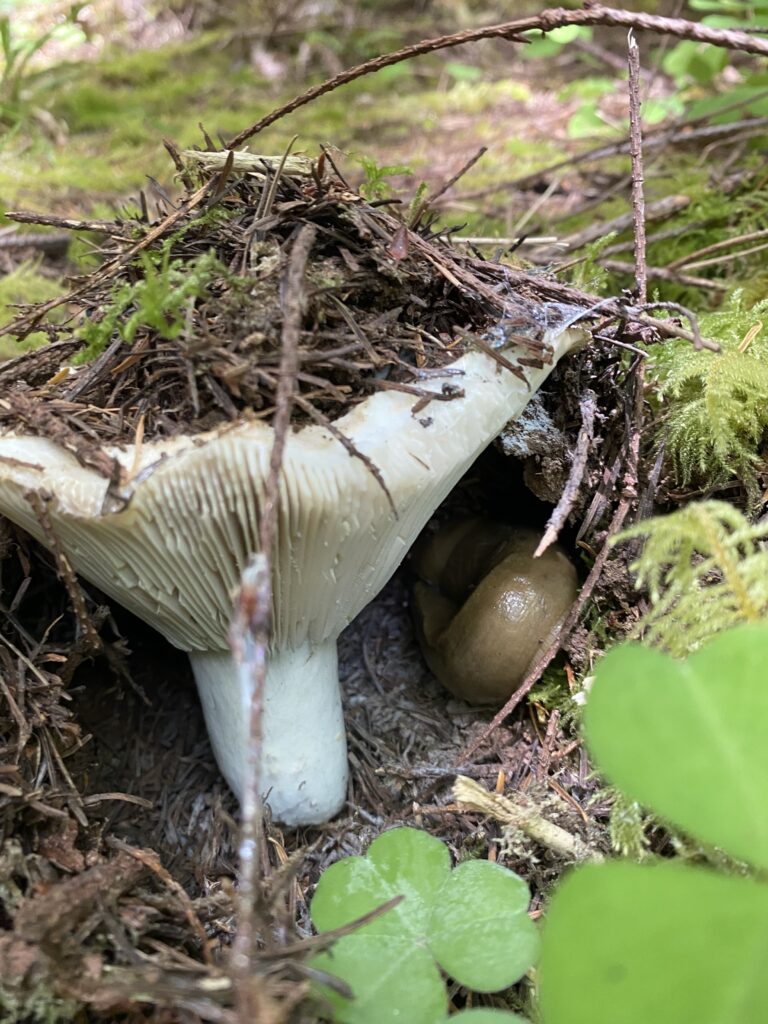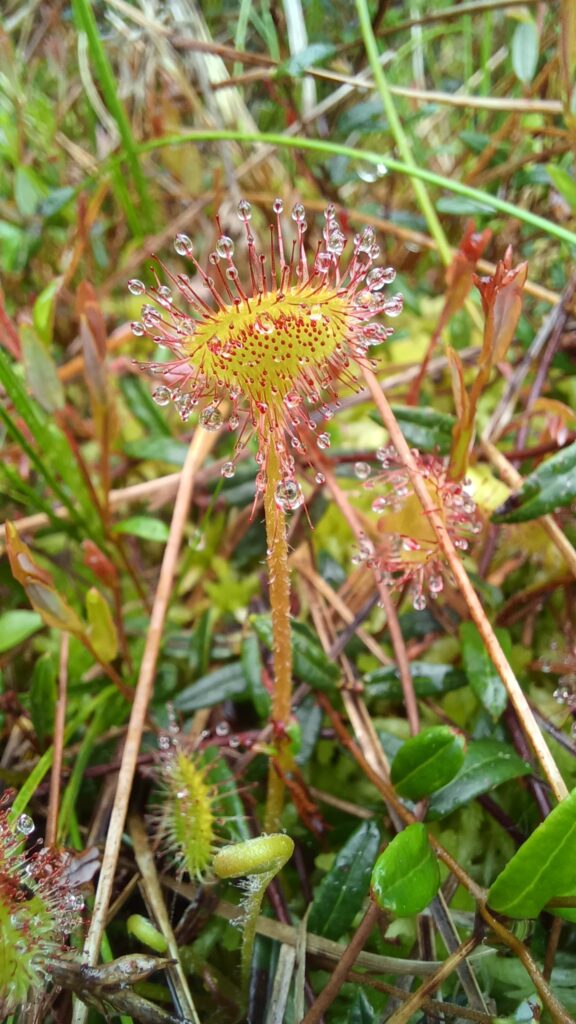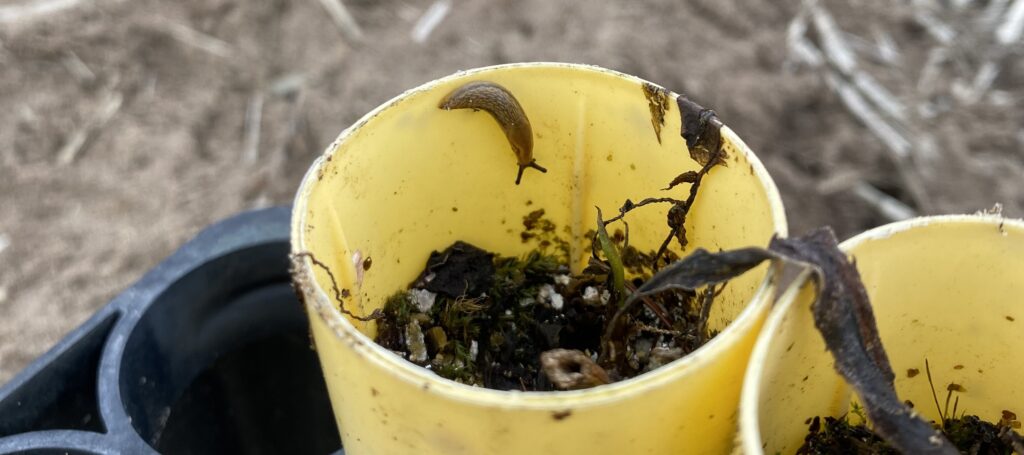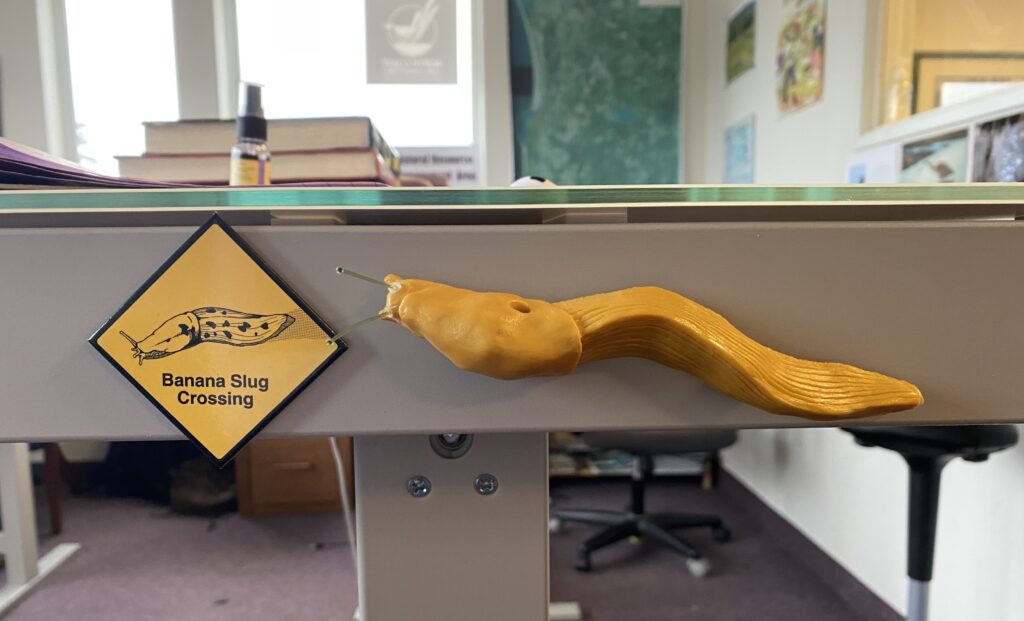Written by: Callista Martin, Stewardship Assistant
Every time I go into the field, I am looking for slugs. With my eyes trained on the ground and the eyes of my bird-loving colleagues looking up at the sky, we’ve got all the terrain covered. While they mimic birdcalls, I yell, “SLUG,” to warn everyone not to step on the squishy slow-movers.
I don’t know exactly when my slug love began, but every new fact I learn about their biology makes my heart grow fonder. Feel free to look up “love darts” or “mating mucus rope,” and I guarantee you, too, will experience fascination, if not love, for these creatures.

(Coming soon to my body is a tattoo based on this photo from the field, a slug I found curled up under a mushroom at NCLC’s Nehalem Bend Conservation Easement. You can’t tell me you’re not charmed by this little guy!)
While soliciting cool slug facts from everyone at a staff meeting, I was reminded of some long-buried knowledge that I learned as a kid: If you lick a banana slug, your tongue will go numb.
I don’t recall ever testing this theory, but perhaps I’m just suppressing that particular memory. Doubtful it would be a pleasant experience.
Anyway, now that I am older and wiser and own a computer, I can investigate the phenomenon without gathering the cold, hard (or slimy) evidence myself.
So my slug slime investigation began. First the motive: What causes the slug to slime? Then the suspects: What part of said slime could potentially cause tongue numbness?
Solving the Banana Slug Mystery
We can find some clues to the motive—why slime?—in our own bodies.
Even without learning about their chemical similarities, you might assume there’s a relationship between snot and slug slime just based on consistency, and you would be absolutely correct. Mucus, the human equivalent of slug slime, is familiar to us all—the lovely substance we get intimate with when we catch a cold, as it drips from the nose and demands to be coughed up from the lungs.
While most of our interactions with our own mucus have negative associations, it provides valuable services for us: coating the exterior of the cells that line the mouth, sinuses, lungs, stomach, intestines, and even the eyeballs. Anywhere that needs to stay moist is where mucus frequents, creating a slip-n-slide like surface that functions to protect these areas from dehydration, as well as helping materials (i.e. food) move smoothly through the passage without causing injury. In addition to this physical barrier of protection that mucus provides, it also protects us from intruders much smaller than a piece of food.
We are constantly breathing in dust, and with it, bacteria and viruses. When these dangerous little guys enter our lungs, the mucus lining does to the microbe what a sundew (Drosera rotundifolia if you’re nasty) does to a fly that lands on its sticky leaves—traps it in place. When that mucus is expelled from the lungs, its microbial hostages go with it, and we avoid infection.
But this is a story about slugs, not people or carnivorous plants, so let’s shift the focus to the stars of the show. Terrestrial slugs do indeed make slime for many of the same reasons our bodies do—hydration and pathogen defense—but they also make it for their own unique purposes: movement, mating, and protection from predators. Slug mucus is significantly more diverse in its uses than our own, which makes sense when you consider that it coats both the outsides and insides of their squishy, slippery bodies. Our external surfaces remain sadly mucus-free, except the eyeballs, which you might think of as two little slugs in your head.
The recipe for slug slime, as it turns out, is at least 90 percent water, sometimes even more. This means the other ingredients present make up only a small fraction of the slime, but their effects must be mighty, and it is here we shall look for the tongue-numbing culprit.

Meet the Suspects
First up are mucins, the slime ingredient that is primarily responsible for its viscous and gel-like consistency. I am a biologist and not a chemist for good reason, so we won’t party too hard on the details, but here is the extremely cool gist: Slug slime is neither a liquid nor a solid, but something in the indefinable in-between. At rest, the slime is like the blue-tack we use to adhere posters to the wall—sticky, but able to maintain the shape in which we position it.
However, when placed under pressure, much like myself, the slime loses its composure and defined shape, taking on the properties of a liquid. Thanks to the ability of mucins to quickly reassemble themselves into new shapes, the slug slime does not seep away into the ground forever, as a spilled glass of milk into the carpet, but rebuilds as soon as stress is lifted. If only I could bounce back that quickly too.
This phenomena is how slugs motor around. Their muscles contract in waves, applying pressure to the slime and then releasing it. I like to picture it like moving around with a grappling hook. As the slugs muscles flex and put stress on the slime, it flows forward, akin to a climber throwing a grappling hook through the air in the direction they want to go. Then the climber pulls, attaching the hook, and uses this anchor to haul themselves in the direction of the hook—the slug relaxes its muscles, and the slime re-solidifies, sticking to the surface they are moving across and acting as a grappling hook that the slug can pull itself towards.
While it may not be the speediest method, you have to admit, slime-based locomotion is a lot more interesting than leg-based!
Ok, so it was pretty obvious from the beginning that mucins have a rock-solid alibi in the case of the tongue-number. They are way too busy moving the slug body around to do anything else, but their contributions to the properties of slug slime were too cool a story to leave out. On to the next.
Slugs can’t hear, nor do they have vocal chords, and their vision is similar to that of my aunt, whose eyesight (before she got Lasik) was so blurry that she was legally blind. While I love the image of a banana slug in tiny Coke-bottle glasses, there are no slug optometrists to my knowledge, so they rely much more heavily on their senses of touch and smell than we do.
This leads us to another element of slug slime: pheromones. These are chemicals that are used to send a message to other individuals, but they are conveyed through smell rather than speech.
Our own bodies also produce pheromones, but we are unable to glean even close to the amount of information from them that a slug is able to, with their souped up sensitivity to smell. Wouldn’t it be incredible if we could read a text message just by taking a whiff of our phones? This is essentially what banana slugs accomplish as they secrete pheromones into the slime trail they leave behind, intended for others to happen upon.
This smelly communication method is especially useful in finding a partner: the forest is a big place, and our slug friends can’t move very fast, but sex must find a way. Banana slugs release specific pheromones into their slimy trail when they are looking for a mate, broadcasting it to others in the area.
Like opening a profile on slug Tinder for the other single slugs in the area to peruse. When there is a match, the interested party can follow the trail of the particular individual until they eventually meet up, and a slug date commences! Oh, the romance of it all.
Pheromones seemed a much more likely culprit than mucins to me—numbness in our own bodies indicates that something is wrong, communicating a specific message, just as pheromones do. But there were still a couple of issues with this theory. First, pheromones are sensed by smell, not touch. Second, they are generally used to make contact between members of the same species, and the tongue numbing occurs between slug and human, not only between slug and slug. Pheromones, you are no longer under investigation.
Having uncovered how slugs utilize their slime for movement and mating, there was only one motive from my list left that could help me piece together who was doing the numbing. It must be providing protection from predators.

The consistency of slug slime on its own does much of the work to discourage animals like snakes, birds, and raccoons from going in for a taste. Raccoons have been known to roll their slug snacks in dirt before attempting to swallow them to reduce the stickiness, which is only made worse by the increase in slime production slugs engage in when they sense a predator attack. If you took a big bite of a delicious hamburger and your mouth immediately filled with a viscous, gummy slime, you might be a little turned off too.
Slime production, of course, is common to all different types of terrestrial slugs. It is only the banana slug that harbors another partner in crime within this sticky defense to help keep them from getting gobbled up.
And the final suspect is… local anesthetic! Yes, the same type of chemical that the dentist will inject into my mouth tomorrow morning when I go in to get a cavity filled. The way anesthetic works is by blocking signals that originate in the nerves from ever making it back to the brain and into our awareness. We typically use anesthetic to keep ourselves blissfully oblivious to pain, the signal our nerves send out to alert us that something is wrong. The side effect of preventing pain is the prevention of feeling sensation at all, resulting in total numbness.
While I will be immensely grateful for this numbness that anesthetic brings on, to understand the experience from, say, a raccoon’s perspective, let’s return to the scene in which you are eating that seemingly delectable hamburger. You take a bite. Your mouth fills with thick slime, which is not fantastic, but maybe you’re still determined. But then, before you can swallow, your tongue, cheeks, and the back of your throat start getting an odd tingling sensation, until finally you’ve lost feeling in them altogether. You spit it out! It’s a poisonous burger for sure!
… This is how I imagine the situation plays out, though sadly, I cannot speak raccoon.
My short stint as a biological detective has come to an end, but hopefully, the burning questions of if and why licking a banana slug will make your tongue go numb have been sufficiently addressed. In this stewardship assistant’s humble opinion, slugs remain criminally understudied—but perhaps, in some instances, it is better to observe from afar rather than getting up close and slimy with them.

Comments
This has long been a question on my mind and it was boggling to me that we have yet to uncover the composition of the chemicals behind the anesthetic properties of banana slug slime. I’ve looked all over the place and there is still no information on this.
Though the question still remains unanswered, thank you for looking into it, and I full heartedly agree. Slugs are very understudied.
I wasn’t feeling sluggish until I read this delightful article! Thanks; now I am not impelled to lick a slug (not that I ever was!) Kudos from a former writing teacher.
Wonderful yarn. Very well done! I am still smiling at the thought.
Love your writing Callista! Just disappointed that you did not end with first-person experience, also known as FAFO, to solve the mystery for us. Sad for me, but not for you. 🙂
Callista, you had me laughing out loud this morning–even before coffee! Thank you for this thorough and lively investigation–I will never look at banana slugs the same way again (and can’t wait to see your tattoo!)
Thanks, Callista. I may never eat a hamburger again:)
It’s nice to be entertained while being educated. You are a great teacher!
Hey Callista! Great piece. Top notch infotainment there. One small correction though. You said there were no slug optometrists. In fact there are. As a UC Santa Cruz alum, aka the Banana Slugs, and a retired optometrist, I’m a slug optometrist! 🙂
Eric
I love this piece! I’m glad we have a Callista on board to answer the questions we never thought to (or were afraid to) ask. What’s next? And BTW, I have a couple of cool slug pictures I’m going to send you. I look at the ground when out in the woods too (mushrooms) and see lots of the critters.
Hey Callista, you are a very engaging writer. I thoroughly enjoyed your article; from henceforth I will never think of banana slugs as uninteresting. One banana slug enjoyed sticking to the back of my barn door. No matter how many times I removed him to the center of my yard, I’d find him back on the door the next day. Do you also like and would be willing to write about Rough-Skinned Newts? They also need people to look down and not step on them, and cars to slow down and not run them over. Looking forward to more articles from you.
What a fantastic and well-written fun article about slugs to read!
Thank you for the good information as well!
KWH